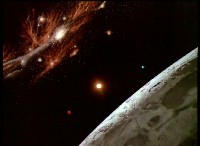The Last Enemy
Moonbase Alpha finds itself caught up in a war between two planets -and the wiles of a beautiful woman. ITC summary
- According to Bob Kellett, the idea of the episode was suggested by Barbara Bain, although he was not clear what she really wanted for the story.
- Shooting script titled "The Second Sex" 25th October 1974
- Shooting schedule 7 November 1974; Gerry Anderson sent a letter to the Landaus indicating the use of A and B filming crews.
- Script title was revised first to "The Other Enemy", then "The Last Enemy", probably during shooting
- Filmed 8 November- 19 November 1974, additional sequences filmed 25 February- 27 February 1975
- Problems with the episode meant Johnny Byrne scripted new scenes which were filmed later (notably the ending). These were filmed in February 1975, after Testament Of Arkadia
- The first major use of a matte painting, for the Bethan surface. Only the left hand portion of the Betha matte painting is visible in the episode- the right hand side is seen only in the This Episode clips.
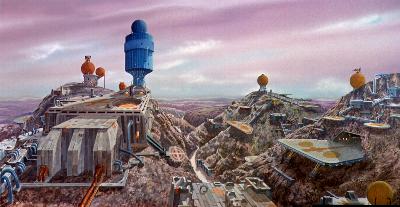
- The original idea was that both Bethan and Deltan ships be the same design, and the same model in different colours. The Satazius was painted green as the Bethan ship, and yellow as the Deltan ship. In the yellow colours a number of publicity shots were taken (More). Unfortunately, both ships were indistinguishable on black and white TVs (which were still widespread in Britain at the time). In later refilming, another model was used for the Deltan battleship.
- The alien bomber was previously seen in Alpha Child and War Games was revamped as the Deltan ship. It would be seen again (in its original form) in Dragon's Domain. The nose piece would appear in The Metamorph.
- The egg-shaped lifeboat was originally designed to drop from the underside of Satazius. The rockets are egg cups. It was seen again in The Metamorph.
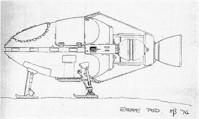
- The missiles had a capsule from The Last Sunset as their top, joined to salt cellars. A gas pipe was used hidden on the opposite side, feeding the rocket flame. They are 18"/45cm long.
- The close-up hull sections were reused. The Bethan lifeboat platform is the Deltan gun platform.
- The Deltan gun model reappears as an Alphan gun (perhaps salvaged?) in The Dorcons.
- In the This Episode clips but not the episode, we see the Alphan laser tanks only used in The Infernal Machine.
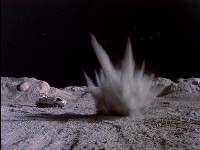
- Publicity pictures of the Satazius with the 22" Eagle model were taken before filming (showing the original yellow colour). Other pictures of the Satazius with the Hawk over Moonbase Alpha were also taken. More
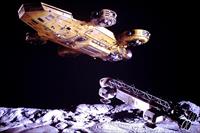
- Deltan ship model photos
- Missile model photo
- Library Special Effects
- Library track: "Cosmic Sounds No. 3" composed by Georges Teperino (Chappell Recorded Music Library). A 40 second track near the start of the episode, this is slowed down here, but in Force Of Life it is played at normal speed.
- ITC Music Cue Sheet
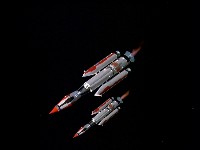
- Rockets do not need a straight line of fire- in fact gravity will curve every trajectory. Current space probes bound for Mars or Venus typically reach their destination approx. 180 degrees (half an interplanetary orbit) away from the starting point. So reaching a planet permanently hidden by the sun would not be particularly difficult. For most of the journey, until it reaches the target, the missile would also be visible and course corrections could be made.
- Betha and Delta apparently orbit a "white dwarf", i.e. a small but very dense star whose diameter typically is only twice that of the Earth. These dim, dying stars have recently (2011) emerged as leading places to look for planets that can support life. Theoretically, a planet orbiting only 1-2 million kilometres from the slowly cooling white dwarf would have a stable temperature suitable for life for billions of years. From the planet, the white dwarf star would look very similar to our Sun since it is much closer. The only major difference is the planet would be tidally locked in the same way as our Moon, so the same side would always face the star and the opposite side would always be in darkness. (by Marcus Lindroos)
- The orbit of Betha and Delta is a typical "Lagrange L3" orbit. It would be stable only if there are no other major planets or stars in the vicinity (gravitational forces closer to one planet would slowly pull it away from its current position while the more distant planet would be less affected).
- Rockets do not need a substantial platform from which to launch (in fact the gravity will mean they need more fuel and more powerful boosters). Satazius is a static target on the moon, so easier to hit. A near miss on the moon would cause damaging shockwaves through the lunar surface and debris; in space only a direct hit would cause damage.
- There is one scenario where being on the Moon is a strategic advantage. If the Satazius is on the far side of the Moon from Delta, its location is hidden. The missiles cannot be detected until they come around the Moon. This is not the case in the episode, as the Satazius is within moonbuggy distance of Moonbase Alpha, and Koenig can look out the windows to see Delta with his binoculars.
- The Alphans cover their ears from the sound of the rocket barrage. The technique of lying down on toes and elbows is used on navy battleships. In the vacuum of space there is no sound, but as the Satazius is on the lunar surface the vibration would be transmitted to the Moonbase.
- The Bethans wave hands over controls- a typical Keith Wilson device.
- There is a reference to "some kind of ultrasonic magnetic distortion". Ultrasonics (sound frequencies beyond human hearing) cannot travel through the vacuum of space.
The gyromagnetic ratio has an anomalous factor two when applied to electron spin. The Landé g-factor expresses the...
In physics, the gyromagnetic ratio of a particle is the ratio of its magnetic dipole moment to its angular momentum. The spin of an isolated election is quantum-mechanical, so classical physics are wrong by a dimensionless quantity called the "g-factor"- the value is just over 2. The Landé g-factor is a particular example of a g-factor, namely for an electron with both spin and orbital angular momentum. It is named after Alfred Landé, who first described it in 1921.
0 fatalities.
Alpha Technology:
- Launch pad 10 is mentioned. There are only 5 pads visible around the base, but according to The Exiles there are outlying stations with their own launch pads as well. Launch pads 6, 8 and 9 are mentioned in The Seance Spectre
- The moonbuggy is seen only as a model.
Eagle 1 (Alan); 2,5
Betha and Delta
Aliens:
Theia, Dione and her crew from Betha; Talos from Delta. Both planets humanoid.
Props:
- Both planets are clearly on the same side of the sun in SFX shots
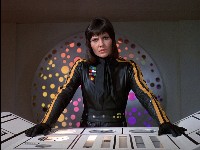
- The title is in reference to 1 Corinthians 14:26 "The last enemy that shall be destroyed is death"
- Dione was in very early Greek mythology the consort and female equivalent of Zeus. Later she became a female Titan and mother of Aphrodite.
- Talos is a name from two Greek legends. One is a pupil of Daedalis who surpassed his teacher's skill and was thrown into the sea by him. The other is the bronze man made by Hephaestrus for Minos to guard the island of Crete.
- The script emphasises how seductive Dione draws the men to her, while Helena is deeply suspicious (this is also reflected in Rankine's novelisation). The sex war becomes a more explicit one on screen: all the Bethans are women, the only Deltan we see is a man.
- In the script, the Bethans want the Deltan resources, but on screen their aim is more vague and the war meaningless (the Deltans are "unreasonable").
- Dione says "We have always been at war.". In George Orwell's 1949 novel "1984", a slogan is "We've always been at war with Eastasia".
- The ending and many scenes of Dione in Satazius were not in the script (Koenig just gives Talos the coordinates of the Satazius).
- Zienia Merton wrote Martin Landau a note during filming of the episode. "When I volunteered for this job it was on the understanding I would have private quarters and I'm not sharing with a ruddy alien."
- The Alpha Computer is hacked, which must explain why Dione refers to the "Eagles".
- Helena says "John, the casualties. We can't take much more!". Yet at the end she states there are only "5 cases of middle ear damage". Perhaps she was worried about potential casualties in the earlier remark. Thanks to Tim Washburn.
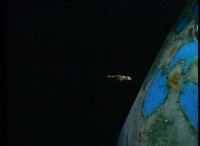
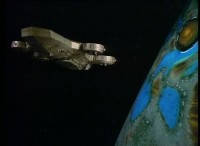
Cut SFX: A longer version of the Satazius leaving orbit, with Betha rotating below it.
- In 1979 the US TV series Wonder Woman used footage of the Satazius over Alpha in the episode Time Bomb
- In 1985 the pop video for "Clouds Across The Moon" by The Rah Band had footage of the Satazius landing on the Moon.
- In November 1986, a clip from the episode was used in a set of questions for the TV quiz Telly Addicts
- "This picture is one of our failures. It went seriously wrong on the floor and needed extensive reshoots.
Performance and direction are extremely poor, and even the high special effects content fail to rescue it." 1/5 Critical Commentary by Johnny Byrne (1975)
External Links
![]() Year 1 - Episode 18
Year 1 - Episode 18 ![]()




